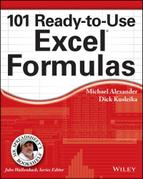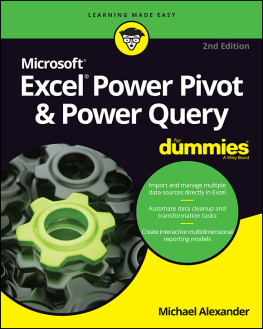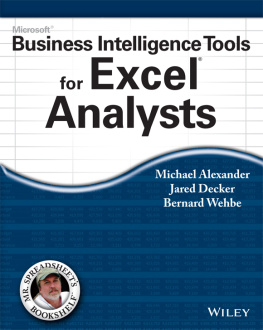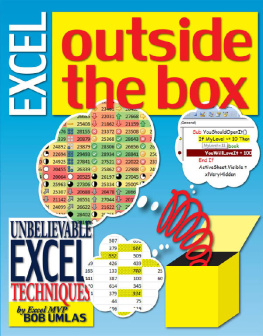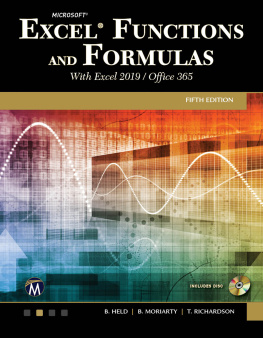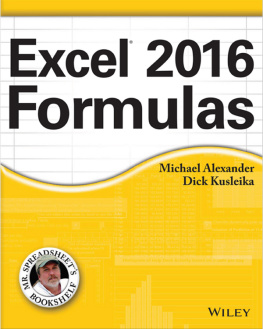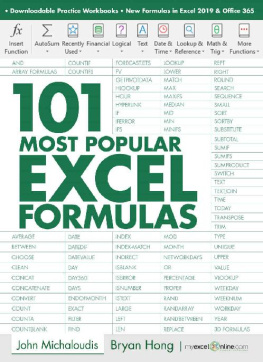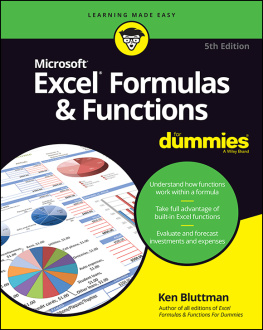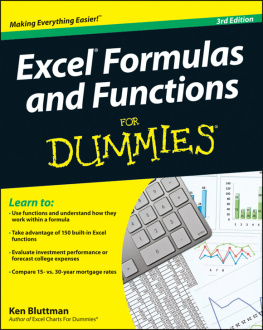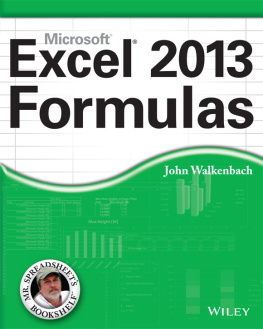
101 Ready-to-Use Excel Formulas
Published by: John Wiley & Sons, Inc., 111 River Street, Hoboken, NJ 07030-5774, www.wiley.com
Copyright 2014 by John Wiley & Sons, Inc., Hoboken, New Jersey
Published simultaneously in Canada
No part of this publication may be reproduced, stored in a retrieval system or transmitted in any form or by any means, electronic, mechanical, photocopying, recording, scanning or otherwise, except as permitted under Sections 107 or 108 of the 1976 United States Copyright Act, without the prior written permission of the Publisher. Requests to the Publisher for permission should be addressed to the Permissions Department, John Wiley & Sons, Inc., 111 River Street, Hoboken, NJ 07030, (201) 748-6011, fax (201) 748-6008, or online at http://www.wiley.com/go/permissions .
Trademarks: Wiley and the Wiley logo are trademarks or registered trademarks of John Wiley & Sons, Inc. and/or its affiliates in the United States and other countries and may not be used without written permission. Microsoft and Excel are registered trademarks of the Microsoft Corporation. All other trademarks are the property of their respective owners. John Wiley & Sons, Inc. is not associated with any product or vendor mentioned in this book.
LIMIT OF LIABILITY/DISCLAIMER OF WARRANTY: THE PUBLISHER AND THE AUTHOR MAKE NO REPRESENTATIONS OR WARRANTIES WITH RESPECT TO THE ACCURACY OR COMPLETENESS OF THE CONTENTS OF THIS WORK AND SPECIFICALLY DISCLAIM ALL WARRANTIES, INCLUDING WITHOUT LIMITATION WARRANTIES OF FITNESS FOR A PARTICULAR PURPOSE. NO WARRANTY MAY BE CREATED OR EXTENDED BY SALES OR PROMOTIONAL MATERIALS. THE ADVICE AND STRATEGIES CONTAINED HEREIN MAY NOT BE SUITABLE FOR EVERY SITUATION. THIS WORK IS SOLD WITH THE UNDERSTANDING THAT THE PUBLISHER IS NOT ENGAGED IN RENDERING LEGAL, ACCOUNTING, OR OTHER PROFESSIONAL SERVICES. IF PROFESSIONAL ASSISTANCE IS REQUIRED, THE SERVICES OF A COMPETENT PROFESSIONAL PERSON SHOULD BE SOUGHT. NEITHER THE PUBLISHER NOR THE AUTHOR SHALL BE LIABLE FOR DAMAGES ARISING HEREFROM. THE FACT THAT AN ORGANIZATION OR WEBSITE IS REFERRED TO IN THIS WORK AS A CITATION AND/OR A POTENTIAL SOURCE OF FURTHER INFORMATION DOES NOT MEAN THAT THE AUTHOR OR THE PUBLISHER ENDORSES THE INFORMATION THE ORGANIZATION OR WEBSITE MAY PROVIDE OR RECOMMENDATIONS IT MAY MAKE. FURTHER, READERS SHOULD BE AWARE THAT INTERNET WEBSITES LISTED IN THIS WORK MAY HAVE CHANGED OR DISAPPEARED BETWEEN WHEN THIS WORK WAS WRITTEN AND WHEN IT IS READ. FULFILLMENT OF EACH COUPON OFFER IS THE SOLE RESPONSIBILITY OF THE OFFEROR.
For general information on our other products and services, please contact our Customer Care Department within the U.S. at 877-762-2974, outside the U.S. at 317-572-3993, or fax 317-572-4002. For technical support, please visit www.wiley.com/techsupport .
Wiley publishes in a variety of print and electronic formats and by print-on-demand. Some material included with standard print versions of this book may not be included in e-books or in print-on-demand. If this book refers to media such as a CD or DVD that is not included in the version you purchased, you may download this material at http://booksupport.wiley.com . For more information about Wiley products, visit www.wiley.com .
Library of Congress Control Number: 2014935514
ISBN 978-1-118-90268-4 (pbk); ISBN 978-1-118-90259-2 (ebk); ISBN 978-1-118-90289-9 (ebk)
Manufactured in the United States of America
10 9 8 7 6 5 4 3 2 1
Introduction
Formulas are the true engines of Excel. Employing various Excel functions, formulas enable Excel analysts to create aggregated reporting, complex calculation engines, clever dashboard models, and much more. Indeed, Excel analysts become more productive as their proficiency with Excel functions and formulas improves.
But building proficiency with Excel functions and formulas takes time. Given that Excel contains more than 400 functions, you could spend months, even years, learning which functions are best for certain tasks and which functions can be combined with others functions.
Unfortunately, many analysts dont have the luxury of taking a few weeks time-out to learn all they need to know about Excel functions and formulas. The scenarios and issues they face require solutions now.
This is where 101 Ready-to-Use Excel Formulas comes in. This book approaches Excel formulas with the assumption that learning comes with accomplishing core tasks. Instead of offering the usual general overview of Excel formula writing, this book provides 101 of the most commonly used, real-world Excel formulas.
For each formula covered, we outline a common problem that needs to be solved and provide the actual Excel formula to solve the problem, along with detailed explanations of how the formula works. This approach lets you use this book as a handy reference for finding a formula that solves a common problem.
After reading about a given formula, you should be able to
- Immediately implement the needed Excel formula
- Understand how the formula works
- Reuse the formula in other workbooks
What You Need to Know
To get the most out of this book, you need to have established certain skills before diving in. The ideal candidate for this book has experience working with data in Excel along with familiarity with the basic concepts of data analysis such as working with tables, aggregating data, performing calculations, and creating charts.
What You Need to Have
You need the following to be able to download and use the examples highlighted in this book:
- A licensed copy of Excel 2010 or Excel 2013
- An Internet connection in order to download the sample files
How This Book Is Organized
Weve grouped this book into nine chapters that are chock-full of tips, techniques, and formulas dedicated to a particular topic.
Chapter 1: Introducing Excel Formulas
Chapter serves as an introduction to Excel formulas, giving you an understanding of how Excel formulas work and some of the ground rules for working with formulas.
Chapter 2: Common Mathematical Operations
In Chapter , you gain insight into some of the fundamental mathematical operations every Excel analyst should know. The formulas found here serve as the foundation for all kinds of advanced data analysis.
Chapter 3: Manipulating Text with Formulas
Chapter focuses on the transformation and shaping of text strings. In this chapter, you explore some of the common text transformation exercises an Excel analyst performs, and in the process, you get a feel for many of the text-based functions Excel has to offer.
Chapter 4: Working with Dates and Times
Chapter gives you a solid understanding of how Excel handles time-based data. Through the prism of the most commonly used date formulas, you discover how to more effectively utilize the dates and times within your data sets.
Chapter 5: Performing Conditional Analysis
In Chapter , you take a look at a wide array of conditional analysis formulas that add flexibility to your analytical processes. With the formulas found here, youll be able to save time, organize your analytical processes, and enhance your data-crunching power.
Chapter 6: Using Lookup Formulas
Chapter focuses on Excels powerful, sometimes intimidating, Lookup formula. The formulas demonstrated in this chapter provide the foundation you need to add depth and power to your Excel data models.

